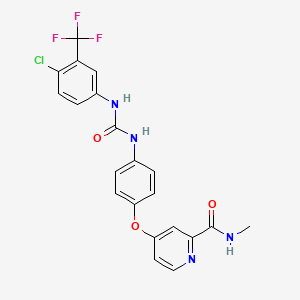


| Pair Name | Amentoflavone, Sorafenib | ||
| Phytochemical Name | Amentoflavone (PubChem CID: 5281600 ) | ||
| Anticancer drug Name | Sorafenib (PubChem CID: 216239 ) | ||
| Structure of Phytochemical |

|
Download
2D
MOL
3D
MOL
|
|
| Structure of Anticancer Drug |

|
Download
2D
MOL
3D
MOL
|
|
| Pair Name | Amentoflavone, Sorafenib | |||
| Disease Info | [ICD-11: 2C12] | Hepatocellular carcinoma | Investigative | |
| Biological Phenomena | Induction-->Apoptosis | |||
| Gene Regulation | Down-regulation | Expression | CASP3 | hsa836 |
| Down-regulation | Expression | CASP8 | hsa841 | |
| Down-regulation | Expression | CASP9 | hsa842 | |
| Down-regulation | Expression | CFLAR | hsa8837 | |
| Down-regulation | Phosphorylation | MAPK3 | hsa5595 | |
| Down-regulation | Expression | MCL1 | hsa4170 | |
| Down-regulation | Expression | XIAP | hsa331 | |
| In Vitro Model | SK-HEP-1 | Liver and intrahepatic bile duct epithelial neoplasm | Homo sapiens (Human) | CVCL_0525 |
| In Vivo Model | To establish the animal model, 1×10⁷ SK-Hep1 cells were suspended in 150 ul mix-ture of serum-free DMEM and matrigel (2: 1) and inoculated subcutaneously in the right legs of nude mice. | |||
| Result | Our results demonstrated that amentoflavone significantly enhanced sorafenib-inhibited tumor growth and expression of ERK/AKT phosphorylation and anti-apoptotic proteins compared to single-agent treatment. Additionally, amentoflavone also triggered sorafenib-induced apoptosis through extrinsic and intrinsic apoptotic pathways. | |||
| Pair Name | Amentoflavone, Sorafenib | |||
| Disease Info | [ICD-11: 2B51] | Osteosarcoma | Investigative | |
| Biological Phenomena | Induction-->Apoptosis | |||
| Gene Regulation | Down-regulation | Phosphorylation | MAPK1 | hsa5594 |
| Down-regulation | Phosphorylation | NFKB1 | hsa4790 | |
| Down-regulation | Expression | VEGFA | hsa7422 | |
| Down-regulation | Expression | MMP9 | hsa4318 | |
| Down-regulation | Expression | XIAP | hsa331 | |
| Down-regulation | Expression | CFLAR | hsa8837 | |
| In Vitro Model | U2OS | Osteosarcoma | Homo sapiens (Human) | CVCL_0042 |
| Result | Amentoflavone may sensitize OS to sorafenib treatment by inducing intrinsic and extrinsic apoptosis and inhibiting ERK/NF-κB signaling transduction. | |||
| Pair Name | Amentoflavone, Sorafenib | |||
| Disease Info | [ICD-11: 2C12] | Hepatocellular carcinoma | Investigative | |
| Biological Phenomena | Induction-->Apoptosis | |||
| Gene Regulation | Up-regulation | Cleavage | CASP3 | hsa836 |
| Up-regulation | Cleavage | CASP8 | hsa841 | |
| Down-regulation | Expression | CFLAR | hsa8837 | |
| Down-regulation | Expression | MCL1 | hsa4170 | |
| Down-regulation | Expression | XIAP | hsa331 | |
| In Vitro Model | SK-HEP-1 | Liver and intrahepatic bile duct epithelial neoplasm | Homo sapiens (Human) | CVCL_0525 |
| Result | Amentoflavone not only reversed sorafenib-induced anti-apoptotic protein levels but also enhanced sorafenib-induced pro-apoptotic protein expression in SK-Hep1R cells. In conclusion, amentoflavone may be used as a sorafenib sensitizer to enhance sorafenib-induced cytotoxicity and trigger sorafenib-induced apoptosis through extrinsic and intrinsic pathways in SK-Hep1R cells. | |||
| No. | Title | Href |
|---|---|---|
| 1 | Amentoflavone Enhances the Therapeutic Efficacy of Sorafenib by Inhibiting Anti-apoptotic Potential and Potentiating Apoptosis in Hepatocellular Carcinoma In Vivo. Anticancer Res. 2018 Apr;38(4):2119-2125. doi: 10.21873/anticanres.12452. | Click |
| 2 | Reinforcement of Sorafenib Anti-osteosarcoma Effect by Amentoflavone Is Associated With the Induction of Apoptosis and Inactivation of ERK/NF-κB. In Vivo. 2022 May-Jun;36(3):1136-1143. doi: 10.21873/invivo.12812. | Click |
| 3 | Amentoflavone enhances sorafenib-induced apoptosis through extrinsic and intrinsic pathways in sorafenib-resistant hepatocellular carcinoma SK-Hep1 cells in vitro. Oncol Lett. 2017 Sep;14(3):3229-3234. doi: 10.3892/ol.2017.6540. | Click |
